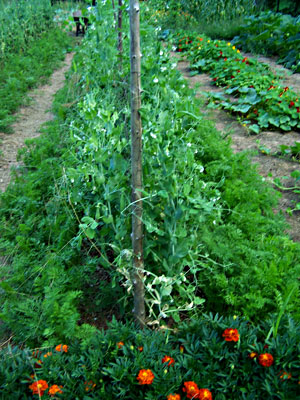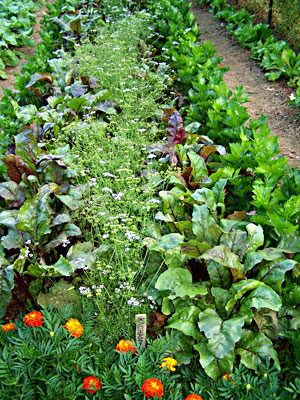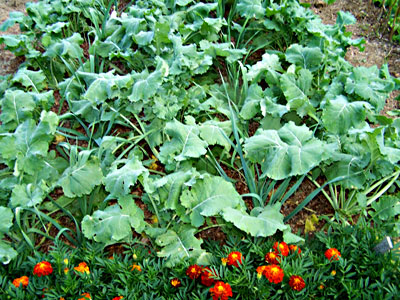 |
| ‘Green Arrow’ peas are planted with two rows of ‘Nantes Fancy’ carrots on either side. Photo courtesy of Will Bonsall. |
By Will Bonsall
Polycultures, intercrops, companion plants – all describe more or less the same idea: growing two or more different crops on the same plot at the same time, in a way that one or more of the partners benefits in some way that it otherwise would not. These combinations may be as ancient as the Native American tradition of Three Sisters – beans, corn, squash – or as modern as a new grouping I’ll try this coming season: chufa (a sedge with an edible tuber) with fenugreek.
The overall objective is greater net yield or quality, and different combinations achieve this in different ways. Some companion plants (e.g., marigolds in cabbage) repel insects that might damage the food crop. Unless you value marigolds greatly for their own sake, you must weigh their repellent value against any cabbage plants they may have displaced (by adjusted spacing).
The benefit is more straightforward when the repellent plant is also a useful crop. For example, I plant nasturtiums among my cukes to deter striped cucumber beetles, spacing my cucumber hills much farther apart so that neither crop overwhelms the other. That might seem like a sacrifice if I didn’t love pickled green nasturtium seeds so much.
An ideal deterrent combo, such as bush beans with potatoes, works both ways. The beans are supposed to repel Colorado potato beetles, and the potatoes repel Mexican bean beetles. In my experience this works – but not as well as I wish. I’ve been told that it works 100 percent against potato beetles if you alternate rows of each crop AND alternate beans within the potato rows – which is nowhere near the proportion in which I eat those foods.
If something only “helps” deter a pest, how good is that? I still have to deal with the problem, although a lesser one. Sometimes that makes little difference, sometimes it makes all the difference. Often the combined effects of two “helpers” exceed the sum of their separate effects. For example, flax also repels potato beetles, most effectively when flax is planted between potato rows AND between potato plants within potato rows. So the potato plants are spaced slightly farther asunder – perhaps 18 inches – which is not a great loss, since flax is an excellent oilseed crop, high in omega-3 fatty acids. But unless you plan to weave your own linen, you won’t need nearly as much flax as potatoes. So I sometimes plant alternate rows of beans and potatoes, with a flax plant (or several) between the potato plants.
 |
| Celeriac is planted on the far left of this bed, then beets, coriander in the center, another row of beets, then celery. Photo courtesy of Will Bonsall. |
Now if potato plants only “help” deter Mexican bean beetles, how can we boost that defense? Well, cosmos plants reportedly repel Mexican bean beetles, and I find that true to some degree. I do find cosmos attractive, but perhaps more important, I don’t make any spatial adjustment for them; I just stick them in every couple of feet within the bean rows, and they don’t crowd anybody. (I use transplants of cosmos so they have a bit of a head start). My experience with each component of this strategy is encouraging, but I’ve had too little experience with polyculture to say it’s a panacea; I assume it is not. However there’s nothing to lose unless you become complacent and assume you can ignore the pests. Companion plants are your allies, not your replacements.
True Crop Insurance
One thing you’ll certainly gain by this complexity is insurance. Regardless of how well the mutual repellent does or doesn’t work, you will have confused pests and interrupted their feeding patterns. Most pest insects locate host plants by color subtleties (to them green is not just green), chemical signals, or sometimes by random landing. A mixed plate confuses them, and as they waste time looking for their next meal, they’re not feeding. For many pests that can be a serious obstacle.
Polyculture offers another type of insurance: If one crop fails, the other presumably assures that your work was not in vain. For example, last year I planted edamame vegetable soybeans in my sweet corn as usual. I barely got a 10 percent crop of edamame, possibly due to woodchucks or bad seed. I had to settle for sweet corn alone, which was the finest crop I’ve ever gotten. Pity me? No way.
Companions and Plant Nutrients
Companions supposedly benefit one another by providing some nutrient that the other requires but cannot easily absorb. The classic example is peas and carrots, a very effective team. We’re told this works because peas fix nitrogen, which carrots need, while carrots, with a taproot, pump up calcium and potassium, which peas need but cannot reach. An elegant explanation, but it is nonsense. Peas (or rather the bacteria in nodules on their roots) fix nitrogen for the peas alone during the current season; if any nitrogen remains after the peas are harvested, it may be available to other crops only after the pea vines die and release their nitrogen – great for ensuing crops but useless for the carrots.
 |
| Kale is interplanted with winter leeks. Photo courtesy of Will Bonsall. |
Likewise carrots mine minerals for their own use; they enrich the soil only after the carrots are dead, assuming their residue is returned to the soil.
Still, these two species are convivial since their self-reliance makes them compete less with each other than peas with peas or carrots with carrots. There must be enough calcium for the peas, but if there is, they don’t have to share it with the carrots; if there is enough nitrate for the carrots, then they may keep it for themselves.
Companionable Plant Morphologies
Beyond the dovetailed nutrient requirements is the spatial relationship of the two companions: a shallow-rooted, foliage-heavy crop such as lettuce will “fit” better with a frilly-leafed taproot such as carrot, whereas carrots and beets will both take umbrage at each other’s close presence.
This spatial harmony is well demonstrated by intercropped field peas and spring wheat. I’ve tried this and the potential seems great, but I’m still tweaking the details. The peas must mature with the wheat, else one will ripen and shatter while the other is still green. Since I cure my wheat in the “stook” the ancient way, succulent pea vines would mold in the sheaf, ruining both crops. This combination is common among traditional farmers in India, who have worked out details of varieties and densities over centuries. It is not simple, but truly organic agriculture is not simple; it is as complicated as life itself. A key feature is that both crops are sown at the same time (I usually drill the peas thinly into every second or third row of wheat; see The MOF&G, June-Aug. 2010), and both crops are mulched with shredded leaves, harvested, cured, threshed and winnowed together. Only then do I screen out the peas for separate use, although I understand that in India the peas are milled with the wheat to give a balanced protein flour.
Sometimes one companion provides only physical support for the other, such as sunflowers and pole beans. For years I grew sunflowers in blocks, in east-west rows 3 feet apart, with plants 12 inches apart within rows. That maximized exposure to prevailing north winds, resulting in significant “lodging” or laying over of the heavy stalks. I realized that planting three plants each in hills 3-foot-square would leave “aisles” in both directions where the wind could travel with less damage. A great idea in theory, but the three plants leaned away from each other to maximize exposure to sun, and THAT caused them to lodge, wind or no.
If only I could hold the sunflowers upright with a pole … but sunflowers ARE poles. Perhaps if I ran a string loosely around the three plants as they grew, they would hold each other up. Then I thought of an easier method. I planted pole dry beans in the hills after the sunflowers were at least a foot high, for two reasons: Sunflowers can be seeded in May when soil is too cold for beans and frost is still likely; and if planted at the same time, the pole beans would be reaching for something to climb on when the sunflowers were too short. The pole beans do not climb up any one stalk, but reach from one to another, tying the whole thing together. In fact they often leap from hill to hill, which is strengthening but a nuisance if you need to walk in there – a serious problem if you grow SNAP beans, which require frequent picking, plus you will miss many green pods hiding in the dense foliage. But DRY pole beans need little attention before harvest, by which time frosts will have shriveled much of the foliage.
Greater Yield Per Unit Area
This brings me to a main principle underlying intercropping: NET yield.
With many (but not all) companions, you have to decrease planting density for each to avoid crowding. If you plant each partner at half its usual spacing, and if each partner gives its usual yield, you will have neither gained nor lost anything; you will come out the same. But if companions are compatible, you WILL gain something – pest protection, space sharing, support, etc. – that will confer some advantage on one or both parties, and thus boost yields. Anything above 50 percent each adds to more than 100 percent.
Actually what I’m describing is a worst-case scenario. Consider pole beans on sunflowers. I plant the sunflowers at their usual density (100 percent), as if they were alone. I then plant six pole beans per hill, 6 inches apart, which is 67 percent their normal density. The sunflowers seem to suffer not a bit from this; indeed, the entwining beans prevent them from lodging, so I may be getting more than 100 percent of expected yield. And the beans? They must be repressed somewhat by the shade of the plants they are supporting, but it’s hard to tell; they appear to yield at least half of what they would on naked poles (remember they were planted at 67 percent density); I’ve never checked that very carefully. But if I view the sunflowers as the main crop (they’re an important staple in my diet) and the pole beans as an add-on, then the bean yield is gravy; the sum of the parts is about 160 percent or better.
Now consider sweet corn with edamame soy. As with sunflowers, I plant corn at 100 percent of the usual spacing (as if it were alone): 36 inches between rows and 12 inches asunder, after thinning. At the same time (since both corn and soy tolerate some frost), I plant soybeans in the same furrow, roughly 6 inches apart – perhaps half what they would be alone. The corn seems unfazed by the presence of the soy. As explained before, the soy doesn’t give the corn any nitrate, but neither does the corn have to share the nitrogen available to it. I expect 100 percent yield of corn and have never been disappointed. The corn shades the soybeans somewhat, but the yield doesn’t reflect that very much. Although the soy planting density is only 50 percent, the sparser planting seems to give an over compensating yield per plant – the soy appears to suffer more from crowding by other soy plants than from corn. Thus my NET yield from both crops is a remarkable 160 percent or better.
Many repellent plants are useful only as repellents, or one cannot realistically use the amount required to protect the crop. That’s not a problem if the repellent plants can be grown among the crop without sacrificing any of the latter – cosmos in bush beans for example. Planting horseradish “at the corners” of your potato patch is said to deter Colorado potato beetles, but how small must that “patch” be? I tried it and saw little effect beyond the persistence of horseradish in those spots for many years after the potatoes were rotated elsewhere.
Likewise we planted mint in our cabbage as recommended to deter white moths. It probably worked well; all I remember is spending the next couple of seasons weeding out mint. Failure is the mother of wisdom.
Another way to use intercropping to boost yields has nothing to do with repelling pests or dovetailing nutrient uptake. It is simply a matter of using space that is available now but won’t be later. Cukes with nasturtiums, for example, won’t need all that space until early July when the cukes start to sprawl. Meanwhile certain early, short-season crops can fill that vacant space as long as they’re harvested before the cuke vines overwhelm them. As dietary mainstays, most candidates are pretty lightweight: radish, endive, lettuce, spinach, fennel, rape greens, scallions. You’ll have more than you want all at once, which may be OK for market gardeners. These “quickie” crops can also be plugged into gaps in major crops where seed has failed to germinate, or cutworms have felled a plant and it’s too late to replace it. But with my large and scattered gardens, will I remember those few lettuce plants hiding among the tomatoes? Not reliably, but it’s worth trying.
Numerous books and websites list dozens of companion possibilities. Most agree with my own experience – although the title of the best-known book, Carrots Love Tomatoes, is an egregious error; carrots are badly stunted by the proximity of tomatoes. Many of these sources lack detail, however; e.g., how should companions be configured, how dense, what timing, how about access for cultivating and harvesting, etc.? One year my parents decided to intercrop table peas with carrots. I plant these together in wide beds, a row of peas down the middle with a double row of carrots on either side. My parents mixed theirs together in single rows. To accommodate the carrots they seeded the peas excessively thin (peas love crowding, by the way). They sacrificed too many peas without a commensurate gain in carrots, and they still had the same amount of wasted space between rows. They also could not thin or pull early carrots to enjoy without damaging the peas. They concluded that this combining nonsense wasn’t for them.
Repelling and Attracting Pests
Likewise, everyone recommends onions for repelling various pests, especially carrot rust fly. True enough, but BULB onions do poorly in close spacings with most other crops. They may grow fine in a little shade, but they won’t “bulb up” as well. So I plant bulb onions by themselves – perhaps with some frilly thing like coriander or poppies down the middle of the bed – and use scallions, or bunching onions, as a close companion with other crops.
Some companion plants are valued because they ATTRACT pests, presumably away from the desired crop. For example eggplant will lure Colorado potato beetles away from potato plants. They’re called “trap crops,” which is somewhat misleading, because the pest is free to return to the main crop and eventually will, especially after increasing its numbers on the trap. The assumption is that as pests concentrate on the trap, you will catch them there and destroy them; but if you neglect that, you may aggravate your problem. If you’re diligent it’s a good tool.
Enhanced Quality and Diversity
The advantage of any practice is measured not only in increased yield but in quality. Chamomile “enhances flavor” in certain companions (cabbage, onions, cukes) by boosting their production of essential oils. Yarrow has a similar effect, especially on other herbs. Of course, “enhanced flavor” can be a matter of taste preference: Chervil makes radishes taste “spicier” – that means “hotter”; great, if that’s what you like.
I’ve found most of these specific claims for companion species to be quite accurate, at least to some degree. “Old wives’ tales” mustn’t be dismissed too hastily (leastwise by us “old husbands”). However there’s nothing like personal experience to sort through clouds of hearsay and heresy. I read somewhere that soybeans deter Japanese beetles – yeah, and garbage deters houseflies!
And some ideas are good as far as they go: comfrey is supposed to enhance the health of practically any plant that grows near it. Wonderful, but how do I use that fact without turning my entire farm into a forever comfrey patch? Could I get similar results from comfrey tea? To what extent could I use tea from other repellent plants, rather than tie up crop space with live plants, especially if those plants threaten to become a nuisance? Sometimes we can and probably should substitute an extract, such as horseradish in potatoes. But in many cases, I suspect the protective or promotional benefit is more complex than some chemical exudates, and may require the presence of live plants with their mingling rootlets, foliage and flowers. Furthermore, although it may be more cost-effective to merely spray one crop with some high-potency extract, I am reluctant to do anything that makes my garden a less diverse place.
About the author: Will Bonsall lives in Industry, Maine, where he directs Scatterseed Project, a seed saving enterprise. His extensive, bountiful and beautiful gardens are open for tours two days each summer. Dates will be listed in the June-August issue of The MOF&G.
